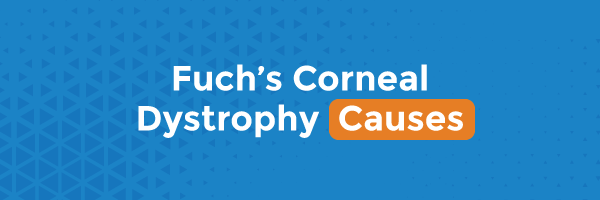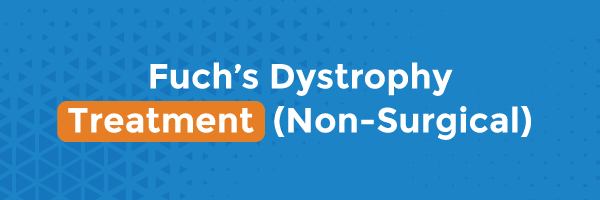Fuch’s Dystrophy
Fuchs dystrophy is a disease during which excess fluid builds up in the cornea, causing it to swell, thicken, and disturb vision. Patients with Fuchs may experience glare, blurred, or cloudy vision, color halos around light, and eye discomfort. Overtime, these symptoms gradually progress and affect the patient’s overall vision. In its early stages, Fuchs can be treated successfully without surgery. However, if the disease advances, a partial corneal transplant or other corneal surgery may be needed.
Our team of experienced Portland OR ophthalmologists specialize in treating Fuchs dystrophy and are here to support you on your journey to clearer vision. If you’re interested to learn more about Fuchs disease or your treatment options, contact us and schedule an appointment today!

Fuch’s Corneal Dystrophy Causes
Fuchs dystrophy is caused by the destruction of endothelium cells in the cornea. Endothelium cells help to balance the fluids in your cornea, and without them, excess fluid builds up over time. Fuchs is believed to be a heritable condition that is passed down and caused by a genetic mutation. It usually starts between the ages of 30 and 40 years old, though many people don’t develop symptoms until their 50s or 60s.

Fuch’s Dystrophy Symptoms
Fuchs dystrophy typically affects both eyes. The symptoms of Fuchs dystrophy tend to worsen over time and include the following: blurred or cloudy vision, glare, night vision problems, swelling, a gritty-like feeling in your eye, seeing color halos around light, foreign body sensation, fluctuation in vision, and eye discomfort or pain. If these symptoms develop or worsen suddenly, you should seek an appointment with a specialist immediately.

Fuch’s Dystrophy Stages
In Fuchs early stages, symptoms are often more mild and can be difficult to detect. That’s why it’s important to have routine eye exams and contact an eye doctor immediately if you notice any symptoms. If Fuchs is detected early on, surgery may be avoided.
In its more advanced stages, symptoms become more severe and difficult to ignore. For example, tiny blisters can form on the surface of your cornea, which can be painful. At this later stage, Fuchs will likely require a partial corneal transplant surgery.
Sometimes, patients develop cataracts on top of Fuchs disease as it progresses. This may require both cataract surgery and corneal transplant surgery.

Fuch’s Dystrophy Treatment (Non-Surgical)
The goal in the treatment of Fuchs is to maintain the clarity and normal thickness of the cornea as well as to preserve vision. As mentioned above, the proper treatment for Fuchs depends on the stage of the disease. If detected early, non-surgical treatment is possible; an eye doctor can observe and maintain the cornea lubricated and thin by applying hypertonic 5% sodium chloride eye drops. This will keep the cornea dehydrated by removing the excess fluid from it.

Fuch’s Dystrophy Surgery
In more advanced cases of Fuchs, non-surgical treatment is ineffective and a surgical approach is preferred. DSEK corneal transplant surgery is often still used as a treatment with good results for Fuchs endothelial dystrophy. During the DSEK procedure, the sick endothelial cell layer is removed and replaced with a healthy endothelial cell layer and a portion of posterior stroma.
There is also a newer and more advanced surgical procedure for treatment of Fuchs endothelial dystrophy called DMEK, in which we replace the sick endothelial cell layer for a healthy endothelial cell layer without any attached posterior stroma. This method has a a faster recovery time, results in better end vision, and has a much lower risk of rejection. It is a painless outpatient surgery that has excellent results in treating Fuchs.

Fuch’s Dystrophy FAQs
What is Fuch’s Dystrophy?
Fuchs dystrophy is a disease during which excess fluid builds up in the cornea, causing it to swell, thicken, and disturb vision.
How Common is Fuch’s Dystrophy?
The late-onset form of Fuchs dystrophy is a common condition which affects close to 4 percent of people over the age of 40 in the United States. The early-onset form of Fuchs dystrophy is much more rare.
How Serious is Fuch’s Dystrophy?
Although symptoms during the early stages of Fuchs are not severe, it is a progressive disease. Overtime, your vision can be so impacted that you have trouble driving, reading, and taking part in other daily activities.
What Are Fuch’s Dystrophy Natural Treatment Options?
Natural treatment can supplement conventional treatment of Fuchs and help improve overall eye health. Talk to your eye doctor to learn more about how antioxidants, dietary supplements, homeopathic eye drops, UV glasses, and other natural remedies may be helpful in your case.
Questions About Fuch’s Dystrophy and Driving
As Fuchs dystrophy progresses, it can cause unclear vision and difficulty with nighttime vision, which can make driving dangerous. See an eye doctor about your symptoms early to minimize interference with your way of life.
Can You Go Blind from Fuch’s Dystrophy?
Fuchs dystrophy does not cause total blindness, even in advanced stages of the condition, but it can severely impair vision and interfere with your daily activities as it worsens over time.
Is Fuch’s Dystrophy Genetic?
Yes, Fuchs dystrophy is a disease which is usually inherited and caused by a genetic mutation.
Connect with Portland Oregon Fuch’s Dystrophy Specialists!

At NW Cornea Institute our experts can properly diagnose and treat Fuch’s endothelial dystrophy, as world innovators and breakthrough researchers for this disease you can be confident you will get the best treatment option for Fuchs endothelial dystrophy.
Click Here to request and appointment with our doctors!